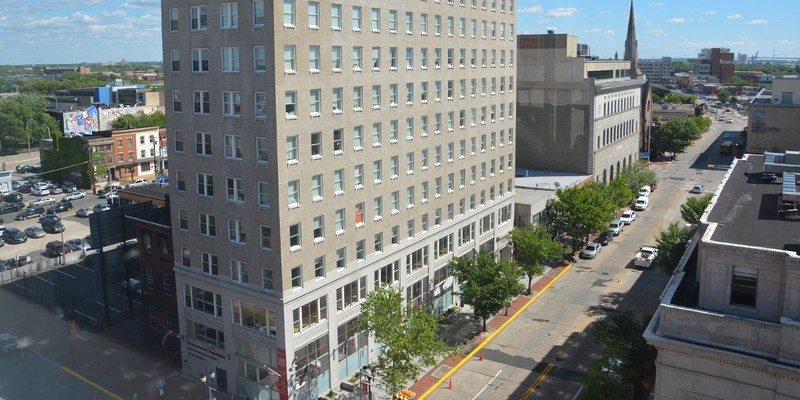Wilson Building in Camden, New Jersey
Introduction
Text-to-speech Audio
Images
Wilson Building in Camden, New Jersey

Backstory and Context
Text-to-speech Audio
The Wilson Building arose during the economic boom of the 1920s as Camden's first skyscraper. When it opened in 1926, the twelve-story, Neo-Classic Wilson Building served the Philadelphia suburb as its largest and most luxurious office building, including a high-speed elevator and 150 offices. Construction of the building not only spoke to the national economic expansion but the growth of the suburb -- the Greater Camden movement, tied to the erection of a new bridge connecting Camden to Philadelphia.
John O. Wilson, a Camden attorney, served as the Wilson Corporation president and felt confident that the industrial city's growth would continue, thus worthy of his investment. Until the Wilson Building construction, most lawyers and professionals maintained offices in small buildings, often requiring renovations and re-designs. Wilson thought that the growing suburb needed more adequate facilities to host businesses, notably luxury office buildings, so he, along with Joseph Bernhard, spent $1 million (1926 dollars) on the skyscraper that now bears his name.
The skyscraper's Neo-Classical brick and limestone exterior exemplified the architectural trends of office-building construction throughout the nation's largest cities during the 1920s. The inclusion of high-speed elevators and an interior abound in spacious offices and ornate detailing speaks to Wilson's desire to attract tenants, which he did effectively. Offices mainly served attorneys and insurance agencies, but investment firms, real estate agents, and the Camden Bar Association Library also occupied office spaces within the Wilson skyscraper. Wilson likewise maintained an office on the top floor, which offered him a scenic view.
The Wilson Building also attracted lawyers and investors due to its proximity to the Camden County Court House, City Hall, and notable banks. By 1929, the city directory showed the Wilson Building as fully occupied. That same year, not long before the Great Depression began, the Wilson Corporation sold the building to the West Jersey Trust Company for a $150,000 profit. In 1939, the Federal Deposit Insurance Corporation took possession of the building, followed by the Broadway-Cooper Corporation and then Dr. Joseph Waldmen in 1948. By the 1950s, much of Camden's industry and manufacturing enterprises either ceased operating or moved.
The void of industrial jobs, urban blight, and "white flight" affected Camden, a town known for its decline and crime more than anything positive. And the Wilson Building suffered alongside the city, slowly deteriorating and showing signs of aging during the second half of the twentieth century, although it remained functional until the 1990s. By then, the building stood vacant and part of a community that no longer thrived as it had done during the 1920s. Although a few owners and plans (including one to demolish the building) came and went, it wasn't until 2014 that the building received new life again. The Leap Academy charter school purchased and renovated the building and now uses it as its high school, and it stands as a mark of community revitalization.
The Wilson Building stands today as a monument to 1920s optimism and twenty-first-century rejuvenation. The building arose when speculators, such as John Wilson, saw Camden as a suburban city primed for growth. However, the Great Depression, World War II, and industrial decline changed the city's outlook for much of the twentieth century. But, led by the charter school, Camden has rebounded. The renovated Wilson tower remains Camden's tallest and most prominent building.
Sources
Cohen, Phil. "Camden, New Jersey: Wilson Building (also known as The West Jersey Trust Building)." dvrbs.com. Accessed January 2, 2021. http://www.dvrbs.com/camden/CamdenNJ-WilsonBuilding.htm.
Gillette, Howard. Camden After the Fall: Decline and Renewal in a Post-Industrial City. University of Pennsylvania Press, 2005. Accessed January 2, 2021. http://www.jstor.org/stable/j.ctt3fhqkq.
Gregg, Cherr. "Work Begins on New Facility for a Growing Camden, NJ Charter School. CBSN Philly. cbslocal.com. December 1, 2014. https://philadelphia.cbslocal.com/2014/12/01/work-begins-on-new-facility-for-a-growing-camden-nj-charter-school/.
Leap Acadamy Charter Schools. https://www.leapacademycharter.org/.
Thompson, Priscilla M. and Franklyn M. Thompson. "Nomination Form: Wilson Building." National Register of Historic Places. nps.gov. August 24, 1990. https://npgallery.nps.gov/GetAsset/aabf5d5f-11b7-44ca-8fa5-29f05a4f4c54.
https://www.leapacademycharter.org/
